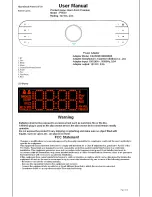
Owner’s Manual
TX-655
Speakers
These in-wall speakers are designed to accurately reproduce music, including today's demanding digital signals. In-wall speakers
are designed so that the wall and the space behind it actually become the speaker cabinet. Mounted flush to the wall, they
require absolutely no floor space. The frames and grilles may be painted to blend with any decor. The discrete, compact format is
ideal for many applications where traditional speakers would be impractical or impossible. In-wall speakers may be used inde-
pendently where space is a consideration, or to bring music to additional rooms in the house. They can also be used to enhance
and enrich subwoofer and surround sound systems, for which they are especially suited.
Speaker Placement
Once installed, in-wall speakers are not easily moved or repositioned. Take a little extra time to carefully consider a good speaker
location before you begin. Each room is unique, so decide what works best for you. Unlike traditional speakers, in-walls mount
flush and cannot be angled or aimed back into the listening area from the corners of a room. As a general rule, the speakers
should be mounted close to, or above, ear level, and at least one-third of the distance from the corner of the room to the center
of the wall or ceiling in which you will mount them.
Allow at least 1
1
•
2
" of clearance between the cut out and any studs or joists for the mounting hardware to work properly. A
mounting depth of 3
1
•
2
" measured from the face of the wall is also required. The speaker location and associated mounting
hardware should not conflict with any existing wires or pipes.
Hooking Up The Wires
The terminals will accommodate up to 16-gauge speaker wire, which should be used for longer connections (greater than 50 feet
of wire). For shorter distances, 18 or 20 gauge speaker wire will be adequate. Leave about two feet of extra wire at the speaker end
to make installation and positioning of the speaker easier. Do not use staples, nails or other metal objects to secure the speaker
wire. The resulting short circuit could affect your system's performance, and could also damage components in your system, espe-
cially the amplifier. You will get the best sound quality and least amount of hum by keeping the speaker wires away from other
electrical wires and cables.




















